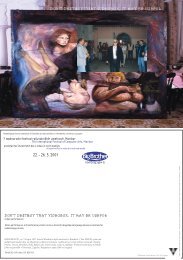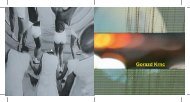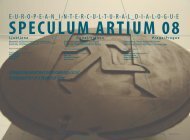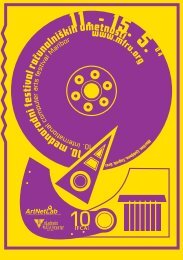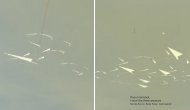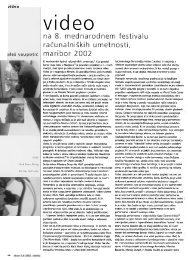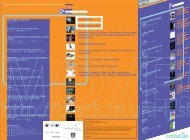Untitled - ArtNetLab
Untitled - ArtNetLab
Untitled - ArtNetLab
- No tags were found...
You also want an ePaper? Increase the reach of your titles
YUMPU automatically turns print PDFs into web optimized ePapers that Google loves.
Društvo za povezovanje umetnosti in znanosti <strong>ArtNetLab</strong> je produkcijsko-organizacijskaentiteta, ki vzpostavlja platformo za nastajanje novomedijskih umetniških projektovnajmlajših generacij umetnikov, tako da nudi organizacijsko podporo sodelovanju medAkademijo za likovno umetnost in oblikovanje ter Fakulteto za računalništvo in informatikoUniverze v Ljubljani. Osrednja institucija <strong>ArtNetLab</strong>a je organiziranje Mednarodnegafestivala računalniških umetnosti, ki omogoča tako realizacijo kot predstavitev del,obenem pa odpira možnost neposrednega stika novih novomedijskih del z mednarodnouveljavljenimi projekti s tega področja. Aleš Vaupotič, <strong>ArtNetLab</strong>Society for Connecting Art and Science <strong>ArtNetLab</strong> establishes a platform for productionmanagement of new media art projects by the youngest generations of artists. It offersorganisational support for the collaboration of the Academy of fine art and design andthe Faculty of computer and information science, University of Ljubljana. The keyinstitution of <strong>ArtNetLab</strong> is our organization of the International Festival of Computer Arts,making possible the realization and presentation of the works and at the same timeopening up the possibility of direct contact of the new new media works withinternationally established projects from this field. Aleš Vaupotič, <strong>ArtNetLab</strong>Tilen Žbona: Hybrid - Subjects (2005), Potopitev/Sinking (2006), Panorama (2006)Besedila/Texts: Narvika Bovcon, Tilen Žbona.Uredili/Edited by: Narvika Bovcon, Aleš Vaupotič.Založil/Published by: <strong>ArtNetLab</strong> Društvo za povezovanje umetnosti in znanosti.<strong>ArtNetLab</strong> Društvo za povezovanje umetnosti in znanosti/<strong>ArtNetLab</strong>Society for Connecting Art and Science,Trubarjeva 76a, 1000 Ljubljananarvika.bovcon@guest.arnes.sihttp://black.fri.uni-lj.si/Zanj/Presented by: Aleš Vaupotič.Prevod/Translation: Sunčan Stone.Oblikovanje/Design: Tilen Žbona, Narvika Bovcon.Tisk/Print: VZA Logatec.Naklada/Number of copies: 300.Leto/Year: 2007.Zahvala/Thanks to:Srečo Dragan, Franc Solina, Dušan Bučar, Matjaž Jogan, Narvika Bovcon, Aleš Vaupotič.CIP - Kataložni zapis o publikacijiNarodna in univerzitetna knjižnica, Ljubljana7.038.55(497.4):929Žbona T.ŽBONA, TilenTilen Žbona / [besedila Narvika Bovcon, Tilen Žbona]. -Ljubljana : <strong>ArtNetLab</strong> - Društvo za povezovanje umetnosti inznanosti, 2007ISBN 978-961-92000-2-5Tilen ŽbonaRojen leta 31.8. 1976 v Kopru. Leta 1991 se je vpisal na Umetniški inštitut v Trstu E.e U. Nordio (Italija) - smer oblikovanje. Po zaključenem šolanju(1995) je študij nadaljeval na Akademiji lepih umetnosti v Benetkah (slikarstvo), kjer je diplomiral leta 2001. Od leta 2004 obiskuje postdiplomskištudij videa na Akademiji za likovno umetnost v Ljubljani.Born on 31st August 1976 in Koper (Slovenia). His education in arts began in 1991 at the Trieste Art Institute E.e U. Nordio in Italy, where he attendedthe course in Decoration. In 1995 he continued his studies at the Academy of Fine Arts in Venice, Italy, where he studied painting (graduated on1.3.2001). Since 2004 he is a postgraduate student of Video at the Academy of Fine Arts in Ljubljana, Slovenia.SAMOSTOJNE RAZSTAVE / SOLO EXHIBITIONS2000 Izola, Mi klub: Millenium: slike in happening / paintings and happening2002 Ljubljana, Parsek Company: slike / paintings2004 Udine / Videm (Italija / Italia / Italy), Galleria del Girasole: slike / paintingsKoper, Galerija Pina: Angel: akvareli / watercolourPortorož, Casino Metropol: slike / paintings2005 Koper, Obalne Galerije Piran/Galerija meduza: Hybrid Subjects (Novi ateljeji)2006 Ljubljana, Galerija Schwarz: slike / paintingsPiran, Krajinski Park Sečoveljske soline: slike / paintingsSKUPINSKE RAZSTAVE / GROUP EXHIBITIONS1997 Piran, Mestna galerija: XXXII. mednarodni slikarski ex tempore / XXXII. international painting ex-tempore1998 Piran, Mestna galerija: XXXIII. mednarodni slikarski ex tempore / XXXIII. international painting ex-tempore(častno priznanje za izvirnost pristopa pri uporabi računalniške risbe / honourable acknowledgement for the development of technology in arts)1999 Koper, Galerija Meduza2001 Piran, Mestna galerija: XXXVI. mednarodni slikarski ex tempore / XXXVI. international painting ex-temporeVenezia (Italija / Italia / Italy), Accademia di Belle Arti: razstava študentov - diplomantov / exhibition of the university graduates2002 Izola, Galerija Insula Izola: Mladi / The young2003 Koper, Pretorska palača ; Palača Gravisi: Mladi / The young2004 Ptuj, Galerija Tenzor: Mladi / I giovani / The youngNova Gorica, Galerija Artes: Medana 2004Cormons (Italija / Italy), Galleria Sala Civica del Comune di Cormons: MMM Art 2004Ljubljana, Galerija Schwarz2005 Ljubljana, <strong>ArtNetLab</strong> produkcija, Minimal Club: Video conferenceMaribor, Razstavni salon Rotovž: 11. mednarodni festival računalniških umetnosti / 11th International Festival of Computer Arts, Maribor,Ljubljana, Koper (Slovenia), Graz (Austria), Zagreb (Croatia)Zagreb (Hrvaška /Croatia), <strong>ArtNetLab</strong> produkcija 2005 MAMA Zagreb.Koper, Muzejska galerija: Ob 60.letnici Gimnazije Koper / 60 years of High school in Koper (dijaki in profesorji / students and teachers)Venezia (Italija / Italy), Centro Culturale Candiani Venezia: Ciphering and Deciphering Video: Images hybrid2006 Ljubljana, Mestna galerija: 12. mednarodni festival računalniških umetnosti /12th International Festival of Computer Arts, Ljubljana, MariborLjubljana, Kiberpipa: panorama 360*Ljubljana, Galerija Spomeniškovarstvenega centra Ljubljana: <strong>ArtNetLab</strong> produkcija 06Zagreb, MAMA: <strong>ArtNetLab</strong> produkcija 06Gradec, Galerija ESC: <strong>ArtNetLab</strong> produkcija 062007 Koper, Obalne Galerije Piran,Galerija Loža: (Kdo sem? O čem sanjam?) slike / paintings231542784
Potopitev"Lepota je (bila) v očeh opazovalca" v času tradicionalnih umetnosti, danes pa se situacija podvaja, saj opazovalec ni več samosubjekt, ki opazuje - kot (je bil) gledalec umetniškega dela -, ampak z njim in njega opazuje tudi nadzorna kamera, povezana npr. spametnim računalniškim programom za prepoznavanje videnih oblik, ali pa satelit, ki je v zvezi z računalniki, opremljenimi sprogramjem lociranja in prek njih lahko zaznava in vpliva na opazovalčevo mesto v prostoru.Tilen Žbona v projektu Sinking raziskuje novomedijske razsežnosti klasičnih vprašanj o umetnosti, umetniku in umetniškem deluskozi metaforo potopitve v štirih stopnjah. Potopitev poteka skozi ogled videov na dveh ravneh, na ravni gibanja v prostoru in na ravnirazumevanja posameznih stopenj, ki so konceptualizirane v štirih video haikujih. Na prvi stopnji projekt zastavi vprašanjeumetnikovega telesa in umetniškega dela v okvirih medija performansa, ki je reduciran na minimum narativnosti: umetnik je zgoljfizično prisoten. Ali je situacija zaprtega krogotoka video posnetka umetnika ter morda njegovega ekscesnega giba obenem tudi žeumetnina ali ne? Na drugi stopnji "potopitve" video posnetek zabeleži umetnikovo izjavo - ali je umetnikova izjava izjavljanje resniceali pa izjavljanje "umetnosti"? V tretjem videu vidimo umetnikovo delo - v duchampovskem smislu podpis umetnika določa statusumetniškega dela, pa četudi je to odtis njegove pesti na očesu kolega, drugega umetnika. Četrti video je samorefleksiven. V njemkolega - drugi umetnik - artikulira naravo posnetka kot zapisa performansa pred kamero, kot pogleda tretjega skozi objektiv kamere,na posnetku katere je poveljujoči avtor, ne pa kot objektivnega in breziteresno neosebnega dokumenta. S tem ko drugi umetnikprevzame aktivno vlogo režiserja in avtorja vseh štirih videov, se vprašanje o tem, kdo je umetnik in kje je umetnik, ponovi v drugemkrogu, v naslednjih štirih stopnjah potopitve v projekt Sinking, kjer se gledalec zave, da je avtor tega projekta pravzaprav Tilen Žbonain ne prvi umetnik, hkrati pa je zdaj na mestu performerja prav Tilen Žbona kot objekt videa na prvi stopnji.Video projekcija kot del interaktivne instalacije Sinking je razdeljena na štiri ekranske površine, štiri video podobe, med katerimise gledalec v realnem galerijskem prostoru sprehaja po navodilih, ki mu jih narekuje sistem instalacije. Sistem ves čas beležiuporabnikovo mesto v realnem prostoru, ki ga odčituje dlančnik v rokah uporabnika na podlagi prostorskih podatkov, pridobljenihprek triangulacije moči signalov lokalnih brezžičnih omrežij. S tega vidika je sistem Sinking edinstven, "veliki brat" je namrečšokantno poenostavljen na domačo konstelacijo bližnjih cenenih oddajnikov brezžičnega signala, ki jih umetnik izkorišča kot prijazninomad, ne da bi sploh porabljal pretok podatkov internetnih omrežij. S pomočjo kontrolnih signalov sistem locira gledalca v galeriji inmu nato pošlje navodilo, ki se izpiše v grobih črkah - te ne predpostavljajo možnosti ugovora - prek projekcije: "Pojdi v levi zadnji del."Gledalec z dlančnikom v roki lahko sledi navodilu in je zato nagrajen z naslednjo stopnjo potopitve v refleksijo interaktivne instalacije.Ker novomedijsko umetniško delo ni statično in zaključeno, ampak je proces, ki interaktivno vključuje vse tri protagoniste: umetnika,tehnologijo in gledalca, je lahko izjava o umetnosti Tilna Žbone le táko interaktivno in potopitveno delo, v katerem se gledalecspopade s tehnologijo, skozi katero šele lahko vstopi v novomedijski objekt, v katerega je umetnik zakodiral svoje sporočilo.Sinking je po eni strani resnoben projekt, zavezan teoretičnemu razmisleku o obstoju umetnosti, vendar pa je podoba, skozikatero Žbona gradi konceptualne, skorajda filozofske video haikuje, dovolj obscena, da že s samo svojo pojavnostjo zaostrivsakokratno sklepanje v lastno negacijo in novostopenjsko potopitev v problem. Obscenost je tisti vzvod pogleda v realnost - ne večenojen, ampak podvojen skozi pogled stroja -, ki razkriva inherentno brutalnost tovrstne pozicije, skozi sisteme algoritmov oropanevsake ideološke naivnosti o idili stika opazovalca in umetnosti. Obenem pa sama tehnična rešitev, ki namesto satelita invsezajemajočega globalnega sistema pozicioniranja (GPS) duhovito uporablja lokalna omrežja s kratkim dometom, načenjavprašanja kompliciranih tehnologij s presenetljivo ad hoc uporabo sistemov, ki so dostopni marsikomu in že razpostavljeni med nami.Vendar pa ni samo tehnologija obscena, ne pozabljamo, da je tak bil in je tudi pogled opazovalca, ki se sprehaja med štirimi poljipred projekcijo v galeriji in sam v sebi tone skozi stopnje ne/razumevanja in zavračanja tega, kar gleda na videiih.Žbona se je tematiki obscenosti tehnološkega in človeškega pogleda tretjega posvečal že v svojih zgodnjih projektih. Najprej vvideu Unheimlich s pomočjo postopkov hitre montaže. Tudi v drugi interaktivni instalaciji Hybrid Subjects avtor medij videa razume vprvi vrsti skozi principe dialoškosti medija v zanki zaprtega krogotoka, ki vplete tri akterje, protagonista, antagonista in pogledkamere. Tudi v tej instalaciji, kjer kamera zajame podobo gledalca videa in jo vpiše v video posnetek erotičnega plesa dvehzamaskiranih plesalk, je edino gledalec tisti, ki ne nosi maske.Narvika Bovcon
SinkingIn the time of traditional art 'beauty was in the eye of the beholder'. Nowadays the situation has doubled, for the viewer is no longer merely thesubject that observes - as the viewer of a work of art used to be in the past - he is also the observed one, for he is caught on security cameras.These cameras can be linked to smart computer recognition programmes or satellites connected to computers equipped with locating programmesthrough which the viewer's space can be monitored and influenced.In his project Sinking, Tilen Žbona researches the new media extensions of the classical questions on art, the artist and the work of art throughthe metaphor of sinking in four stages. The sinking takes place through watching videos on two different levels, i.e. on the level of moving in realspace and the level of understanding the individual stages that are conceptualised in four video haikus. In the first stage the project poses thequestion of the artist's body and the work of art within the frame of a media performance that is reduced to the minimum narrative: the artist ismerely physically present. Is the situation of a closed circuit video installation of the artist and maybe his excessive move already a work of art ornot? In the second stage of Sinking the video presents the artist's statement - is the artist's statement a statement of truth or an artistic statement?In the third video we can see the artist's work - as stated by Duchamp the signature of the artist defines the status of the work of art - even if this ismerely a mark of the artist's fist on the eye of his colleague artist. The fourth video is self-reflective. In it a colleague - another artist - articulates thenature of the video as a record of the performance in front of a camera, i.e. as a third party view through the lens of the camera. However, the authoris in command of this video, therefore it is not an objective and impersonal document. When the other artist takes over the active role of the directorand author of all four videos, the questions as regards who is the artist and where is the artist repeat themselves in the second round, i.e. in the nextfour stages of sinking within the Sinking project. At this point the viewer actually realises that the author of this project is in fact Tilen Žbona and notthe first artist. At the same time Tilen Žbona is now in the position of the performer as an object of the video in the first stage.As a part of the interactive installation Sinking, the video projection is divided onto four monitors, i.e. we have four video images amongst whichthe viewer walks through the real gallery space according to the instructions given to him by the installation system. With the aid of the Palm held inthe hands of the viewer the system constantly monitors his position in the environment. This is performed through spatial data gained from thesignals from local wireless networks that form a triangle. From this aspect the Sinking system is unique, for 'the big brother' is shockingly simplifiedto the domestic constellation of cheap nearby wireless signal transmitters that are used by the artist who acts as a friendly nomad without evenusing the data flow of internet networks. With the aid of control signals the system locates the viewer's position in the gallery and then sends him amessage written in rough letters - they do not permit any discussion: 'Go to the left back part.' With the Palm in his hand the viewer can follow theinstructions and is thus awarded with the next stage of sinking into the reflection of an interactive installation. Because the new media work of art isnot static or completed, but a process that interactively includes all three protagonists (the artist, technology and the viewer) can a statement onthe art of Tilen Žbona be only such an interactive and sinking work. The viewer has to confront the technology and thereby step-by-step enter intothe new media object into which the artist has coded his message.On one hand Sinking is a serious project, dedicated to a theoretic contemplation on the existence of art; however the image through whichŽbona constructs the conceptual, almost philosophical video haikus, is obscene enough to sharpen every conclusion into a negation and a newlevel of sinking into the problem merely with its appearance. The obscenity is that leaver of the view into reality - no longer single, but a double viewthrough the view of the machine - that reveals the inherent brutality of such a position through the system of algorithms robbed of all ideologicalnaivety as regards the ideal of the contact between the viewer and art. At the same time the technical solution - that instead of a satellite and the allencompassing global positional system (GPS) humorously uses the local short range networks - starts dealing with the issues of complicatedtechnologies with a surprising ad hoc use of the systems that are available to anyone and are already placed amongst us. However, not only is thetechnology obscene, we should also not forget that this was and still is the view of the viewer walking between the four projection fields in thegallery and who sinks into the stages of mis/understanding and rejecting what he sees in the videos.Already in his early projects Žbona focused on the theme of obscenity of the technological and third party human view. First in the videoUnheimlich with the help of scratch montage. In the other interactive installation Hybrid Subjects he understands the medium of video primarilythrough the principles of the medium dialogue within the closed loop that includes three participants: the protagonist, the antagonist and the viewof the camera. In this installation, when the camera catches the image of the video viewer and enters it into the video of an erotic dance performedby two masked dancers, the viewer is the only one not wearing a mask.Narvika Bovcon



